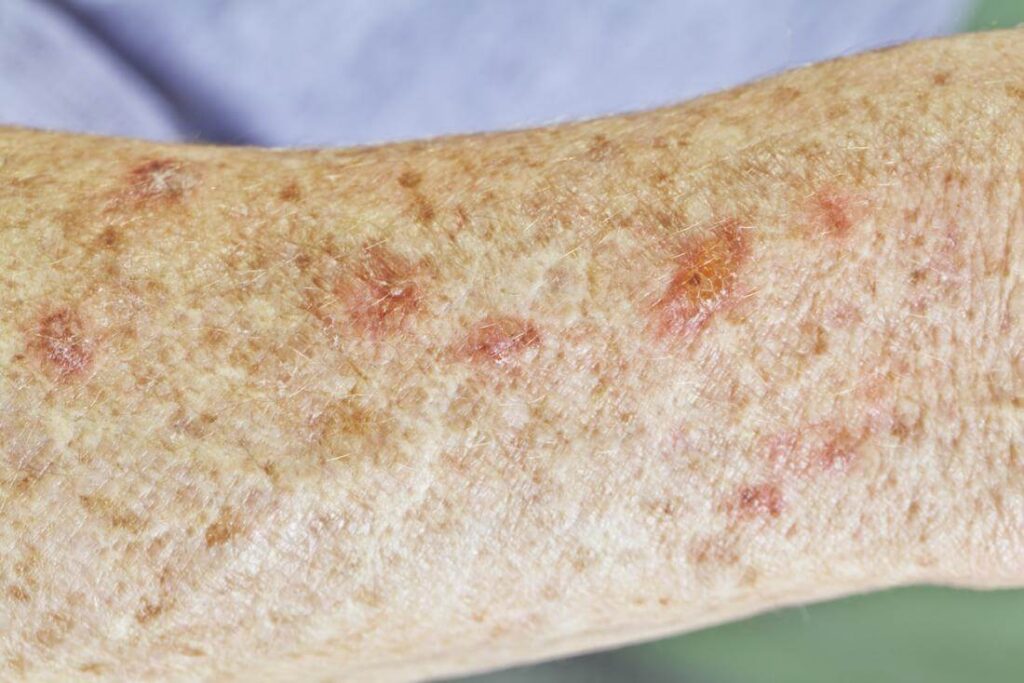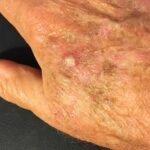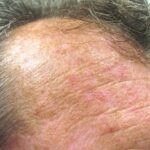Actinic keratosis (AK) is a precancerous skin condition commonly affecting areas exposed to the sun, including the upper extremities. Characterized by rough, scaly patches, actinic keratosis is often a result of prolonged ultraviolet (UV) radiation exposure. Early diagnosis and effective management are critical to prevent progression to squamous cell carcinoma (SCC).

What is Actinic Keratosis?
Actinic keratosis, also known as solar keratosis, is a skin lesion caused by chronic sun damage. These lesions frequently develop on the upper extremities due to their frequent exposure to sunlight. While AK itself is not cancerous, it carries the potential to evolve into SCC, making timely intervention essential.
Common Characteristics of Actinic Keratosis
- Appearance: Rough, scaly, or crusted patches of skin, often red, pink, or brown in color.
- Texture: Sandpaper-like to the touch.
- Location: Commonly found on sun-exposed areas such as the hands, forearms, and shoulders.
- Symptoms: Lesions may cause itching, burning, or tenderness.
Causes and Risk Factors
Actinic keratosis is primarily caused by cumulative UV radiation damage. Several factors contribute to its development:
- Chronic Sun Exposure: Prolonged exposure to UV rays from the sun or tanning beds significantly increases the risk.
- Skin Type: Individuals with fair skin, light-colored eyes, and blond or red hair are at greater risk.
- Age: Older adults are more susceptible due to accumulated sun damage over their lifetime.
- Geographical Location: Living in sunny or high-altitude regions raises the likelihood of sun damage.
- Immune Suppression: Conditions or medications that suppress the immune system can increase susceptibility.
Diagnosis of Actinic Keratosis on the Upper Extremity
Early diagnosis is crucial for managing AK and preventing its progression to skin cancer. Dermatologists often use the following methods to diagnose AK:
- Physical Examination: A thorough visual and tactile inspection of the skin.
- Dermatoscopy: A magnified view of the lesion to assess its features.
- Biopsy: In cases where malignancy is suspected, a skin biopsy may be performed to rule out SCC.
Treatment Options for Actinic Keratosis
Several treatment modalities are available for actinic keratosis. The choice of treatment depends on the number, size, and location of the lesions as well as patient-specific factors.
Topical Therapies
- 5-Fluorouracil (5-FU): A chemotherapy cream that targets abnormal cells, leading to their destruction.
- Imiquimod: An immune response modifier that stimulates the body to attack abnormal cells.
- Diclofenac: A nonsteroidal anti-inflammatory drug (NSAID) that reduces AK lesions over time.
Procedural Treatments
- Cryotherapy: Liquid nitrogen is used to freeze and destroy abnormal cells. This is a quick and effective method for individual lesions.
- Curettage and Electrodessication: Scraping off the lesion followed by electrocautery to destroy remaining cells.
- Photodynamic Therapy (PDT): A photosensitizing agent is applied to the skin, followed by exposure to a specific wavelength of light, which activates the agent and destroys abnormal cells.
Advanced Options
- Chemical Peels: Acidic solutions are applied to remove damaged layers of skin, promoting regeneration.
- Laser Therapy: Ablative lasers are used to vaporize AK lesions, offering precise removal with minimal surrounding damage.
Prevention of Actinic Keratosis
Preventive measures are essential for individuals at risk of developing actinic keratosis or for those who have undergone treatment to avoid recurrence.
Sun Protection
- Broad-Spectrum Sunscreen: Use a sunscreen with SPF 30 or higher, and apply it generously to all exposed areas, including the hands and arms.
- Protective Clothing: Long sleeves, wide-brimmed hats, and UV-blocking fabric can shield the skin from harmful rays.
- Avoid Peak Sun Hours: Limit sun exposure during peak UV radiation hours, typically between 10 AM and 4 PM.
Regular Skin Checks
- Conduct self-examinations to identify new or changing lesions.
- Schedule regular dermatological check-ups, especially for individuals with a history of AK or other skin conditions.
Actinic keratosis of the upper extremity is a preventable and manageable condition with timely diagnosis and treatment. Employing sun protection measures, regular monitoring, and appropriate therapeutic interventions can significantly reduce the risk of progression to squamous cell carcinoma. By prioritizing skin health, individuals can maintain the integrity of their skin and reduce long-term complications.

